- Photos: Anjum Chisti
- Text & Tester: Syed Shiraz
I have always believed that the ’60s was the best time for a guy to be an 18-year old. No, not because of the perceived coital revolution in America, and also not because of the somewhat less-corrupt politicos of that era, but the sole reason behind my wish to go back in time has to be the wonderful motorcycles and cars which that period had to offer. And most of them were affordable…
Rider Gear Check:
- Jacket: Cramster Eclipse
- Gloves: Cramster TRG2 Gloves
- Helmet: LS2 FF351 (Buy LS2 Helmets from Amazon)
Of course, I am not talking about the Bentleys or Brough Superiors; I am referring to World War surplus Jeeps; the stripped-out two-door fastback coupes (better known as ‘muscle cars’) with big V8 motors under their mile-long hoods; and those simple yet beautiful, unpretentious yet potent, Brit singles and twins – yes, the Ariels, BSAs, Matchlesses, Nortons, and Triumphs of that era. And these motorcycles also ran on Indian roads back then… Ask your father (or grandfather); he would know…
These bikes rubbed handlebars with the Bullets and Jawas in India much before I was born, so I don’t know why but somehow the image that always flashes by in my mind, when I see, hear, or say the word ‘motorcycle’, is not dissimilar to that of a classic British motorcycle. It has a round headlamp, two meters, metal fenders, straight saddle, wired wheels, and a bulbous but still beautiful tank with a BIG engine underneath…
Though this description would fit most bikes of that period, irrespective of the country of their origin, I know for sure that the hazy picture processed by my occipital lobe is neither of a Honda CB750 nor even of one of my own Yamaha RD350s. Because even though it’s also an air-cooled parallel twin, the pipes, flowing back from below the footpegs on both sides, vary in diameter towards the end. I also don’t know if I see a timing advance/retard lever in the picture…
So when Triumph said they are giving us the Bonneville for reviewing, I jumped at the opportunity to find out if it comes close to the image that my mind concocts every now and then. I reviewed the bike for some time and here is my understanding of what the bike has to offer…
Design, features, and instrumentation
The Bonneville is offered in two variants: the base model can be differentiated by its single shade of colour and 17-inch alloys, among other things, and it’s the upper version, the Bonneville T100 (which we tested), that’s been given proper retro-chic treatment with dual-tone paint schemes, seat with white piping, hand-painted stripes, and wire wheels – 19-inch at the front and 17-inch at the rear.
Both bikes look absolutely gorgeous, but, viewed head-on, the T100 looks more complete due to its twin pods (the cheaper variant gets only one). And those pods house two of the finest analogue dials I have seen on a bike yet. Simple white-script-on-black looks undeniably classy here and the company has wisely chosen to not clutter speedo and rev units. The former is marked in both mph and km/h and also incorporates a couple of warning lights, including one for low-fuel, along with a rectangular LCD display for odo, clock, and trip readouts. That low-fuel warning light can’t be trusted, but more on that later. The tach pod contains the other tell-tale lights for Neutral, turn-signals, etc.
Like the yesteryears’ Bonnies, there are no fuel and engine-temperature gauges and though that has been done to get the retro-feel right, it’s a glaring omission. Still, I can do without the latter on this one as my legs will tell me if that air-cooled engine needs a break, but while the petcocks of carburetted Bonnies gave you enough miles to scan for the next gas station on your route, a fuel-injected bike, sans a fuel gauge, can put you in a rather sticky spot… No, it would be dumb to think that I am asking Triumph to revert to the erstwhile carb set-up; I am just reiterating the importance of a fuel gauge – electronic or analogue, take your pick, but it has to be there! And yes, those beautifully-crafted 36 mm Keihin throttle bodies have been designed to look like Keihin carburettors and they hide a modern closed-loop multipoint sequential electronic fuel-injection system!
The Bonneville has been in existence since 1959 and if you’ll see the current iteration’s form in light of the original, you’ll notice how perfectly its designers have managed to imbibe the essence of the original. Just look at those metal and rubber emblems on the tank; it looks like Triumph has taken them off the period bike and slapped them on to the new bike! Mind you, the execution would have looked garish in the current age of seamless graphics, but it looks so neatly integrated that even non-purists would come to appreciate and like. Plus, this motorcycle carries just the right chrome-to-paint ratio for a modern classic; passers-by won’t go blind on a sunny day and it’s not all blacked-out either for you to visualize yourself as a caped crusader.
But the RR unit, positioned on the lower triple-clamp below the headlamp, sticks out like a sore thumb. Come on guys, you could have placed it somewhere else! Our test bike was also missing the fork shrouds. When in place, the rubber gaiters hide the inner fork tubes so the forks appear to be completely black, and stylish.
Engine, Gearbox & Performance
Don’t, for even a moment, think if the Bonnie looks like a classic, it will perform like one too; i.e., if you think that classic bikes are all show and no go. In fact, you will be wrong on both counts. Because it was a Bonneville that became the first production motorcycle in the world in 1969 to achieve a more-than-100 mph lap at the legendary Isle of Man TT races. Oh yes, the gentleman riding it, Malcolm Uphill (fitting name!), won that race recording an average of 99.99 mph (approx. 161 km/h). So now you know what the ‘T100’ in the Bonnie’s nomenclature stands for…
And it’s not just the 1969 Bonneville that was fast; the Bonneville was born as a special. Remember the first one, the 1959 model, I talked about earlier? That bike was actually a Triumph Tiger T110 but with a crucial difference – it had two ‘tuned’ carburettors instead of one. The ‘T120’ was thus born, which came to be known as the Bonneville.
With that kind of history behind its name the Bonnie in its latest avatar shouldn’t be a slouch, right? Well, I am happy to report it isn’t. The parallel-twin engine displaces 865 cc which puts out 61 PS of peak power at 7,500 rpm and 61 Nm of maximum torque at 5,550 rpm. The European version produces 68 PS and 68 Nm, but that’s a story for some other day. As of now, to give you a better perspective, let me tell you that Bonnie’s competition in India, the heavier Harley 883 Sportsters (Iron and SuperLow), produce around 50 PS of peak power and 69 Nm of max. torque…
Now with the numbers out of the way let me first tell you that the retro-looking body of the Bonneville houses fully-modern mechanicals, and much thanks to Triumph for that. I have already talked about the EFI being beautifully masked by a pair of AMAL-lookalikes, and most will also be intrigued to see a pushrod engine. If they can identify the type of engine, that is.
Okay, it’s not an old-tech mill; it’s just that in its quest to deliver the best modern classic, Triumph has left no stone unturned in making this one look as much as the original number from any and every angle! Therefore, though the valves (two per cylinder) are operated by dual overhead camshafts, the engine has been designed to look like a pushrod unit, but what appears to be a pushrod tube is actually used to drain the oil.
However, because of the retro looks, I had expected the bike to sound like something on the lines of two out-of-tune-RE-engines, if you know what I mean. But boy, was I in for pleasant surprise! The engine sounds impeccably sweet; it’s like you take an inline-four, subtract two cylinders, reduce the bass, and voila! I love the way it purrs at idle and every twist of the throttle tells you about what’s coming. Non-threatening, torque-laden fun.
The Bonnie feels so torquey in every gear that the linear surge just exceeds what you had expected. Overtaking is a cinch in ALL gears and that’s something you can’t say about most bikes in this class. And the accompanying melodious thrum of the intake reiterates that you aren’t piloting an ordinary bike. The exhaust, which otherwise has subdued vocals, gurgles and spits on the overrun – not my flavour, but the majority of riders will love it. The five-speed gearbox is a delight to use as well in all conditions, but that bountiful torque spread again guarantees that changing gears is something that’s not foremost on your mind. Revelling in winding that throttle is!
Ergonomics, Ride, Handling & Braking
This is a bike that you can just hop on and ride – no adjustments, no silent conversations, no familiarization time needed! Everything – be it handlebar width, angle, and position; controls, seat, footpegs, etc. – feels just right on this motorcycle from the word go. Moreover both the clutch and brake levers’ span can be adjusted via rotary dials. The saddle is quite comfortable within the city, however, I suspect that it could do with more padding for long rides.
Kayaba 41 mm conventional telescopic forks at the front and two hydraulic shock absorbers by the same company at the rear take care of the damping duties. The suspension has been set on the firmer side but the rear setting can be fiddled with for preload. I did not touch it as I found the suspension tune to be near-perfect for around 90 per cent of what the roads in our National Capital Region had to offer. That means your spine will not complain on most surfaces, save for on the worst ones where you would not be riding the Bonnie like its Scrambler sibling anyway.
I did mention earlier that the Bonneville T100 comes with a 19-inch wheel at the front and a 17-incher at the rear. Those wheels get 100/90 and 130/80 section rubber, respectively. The not-so-wide tyre at the front makes the steering effortless but without compromising on grip, which is phenomenal! The Metzelers on this bike reinforce the notion that quality matters more than the, er…, size. The relatively narrow tyres make the bike light on its feet and directional changes hardly require any muscle. That’s a big achievement for a motorcycle that weighs 230 kilos! Again, the agility hasn’t come at the expense of stability, and the Bonnie is more stable at three-digit speeds than most relationships at three months nowadays.
Speaking of which (the speed, I mean) I did manage to glance down once on the speedo and saw 110. That’s mph I am talking about, which equates to around 177 km/h. I had the bike for a brief period so I could not max it out, and though it’s not a prerequisite, but for those who would want to know, let me just say that I did feel the Bonnie would go beyond 190 km/h given a nice, empty stretch of tarmac.
Triumph has equipped this machine with a 310 mm disc at the front and a 255 mm one at the rear, and both of them get Nissin 2-piston floating calipers. Now while the front brake had terrific bite and feel, the rear disc was completely the opposite. My test motorcycle was actually due for a service and I could sense by the constant squealing protests from the rear brake (even at crawling speeds) that the caliper would grab the rotor better after the bike gets its routine TLC at the workshop. Still, relying solely on the front anchor brought the bike safely to a halt every time a cellphone wielding bovine in a cager swerved inconsiderately.
Fuel Efficiency
Triumph lists the urban fuel consumption at 51 miles per gallon or around 18 km/l. I got 12 km/l in maddening city traffic, which means that it should yield around 15 km to a litre of unleaded on highways. A 16-litre tank should be then good for a range of around 225 km. Earlier in the story I had mentioned about the undependable low-fuel warning light. I said so because I had just covered two to three kilometres after taking the delivery of the bike and the tank ran dry without even the warning light coming on! I was on one of the national highways with traffic flowing in at high speeds and I thank my stars to have managed to bring the bike safely on the shoulder when the engine first skipped a beat.
With no fuel pump around for the next 7 kilometres I decided against pushing the bike, which would have been risky anyway (for both the bike and myself). I called up the warehouse manager who brought some fuel and saved the day! Funnily enough, after pouring around two litres of petrol, the low-fuel warning light came on! This might be a one-off case with this bike only but it means that you have to keep a strict check on the odo reading every time you tank up!
Verdict
I’ll start with two complaints: The ignition key slot is not only inconveniently located (read ‘retro’) but its placement also causes the second key, for the handle-lock, to flap about while riding and that’s distracting. And that fuel-tank cap is not lockable! That’s two for you, while the aforementioned RR unit position and the iffy low-fuel warning light round off the problem areas.
But let me tell you something; I would buy this motorcycle even if Triumph places the ignition key slot on my lower back or on some other difficult-to-reach spot, displays the RR unit on the bike’s forehead, and asks me to bring my own fuel-tank cap. And now that I know of the bike’s fuel consumption, I won’t give too hoots about the moody low-fuel warning light either. Why? Because such trivial stuff does not affect the alluring charm of this wonderful motorbike by even a wee bit, that’s why!
No manufacturer, I repeat, no manufacturer has yet been able to the recreate their original’s magic in this manner at this price (INR 6.75 Lakh ex-showroom Delhi). A modern, reliable, and practical motorcycle in a timeless design, and an evocative name that is second to none in pedigree and heritage – what more can you ask for?

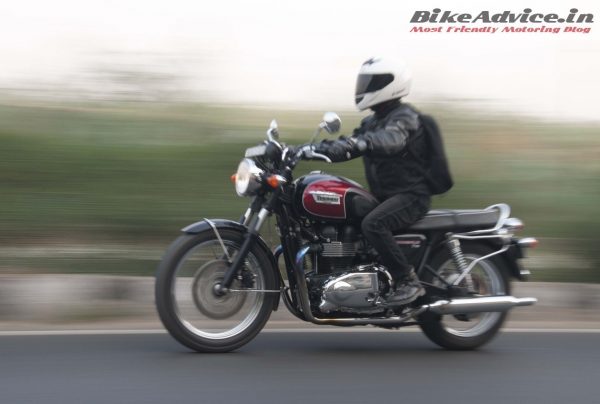
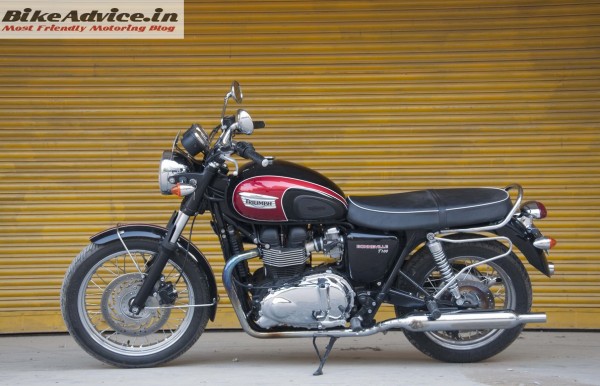
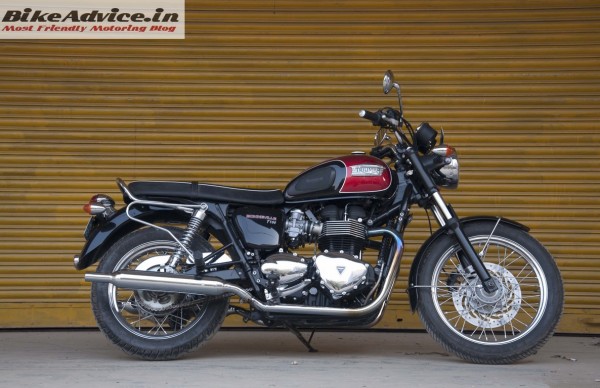
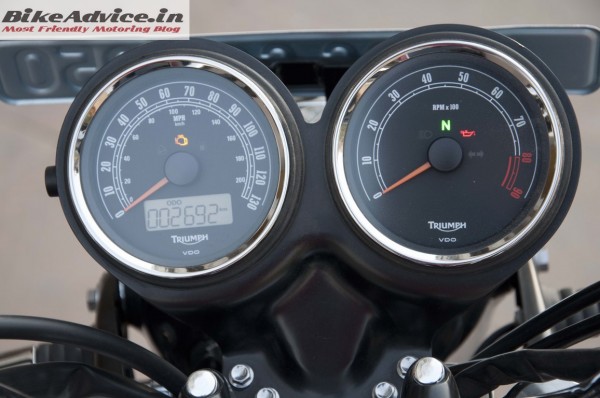
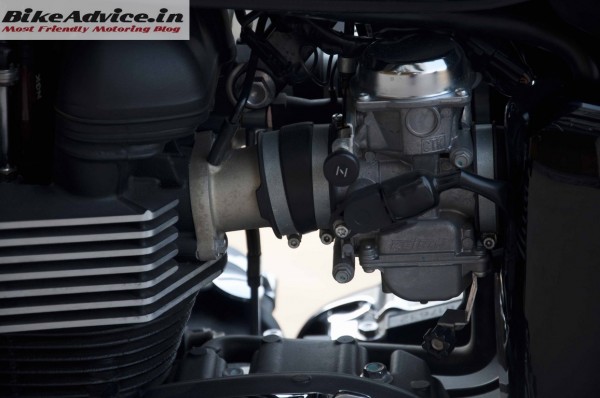
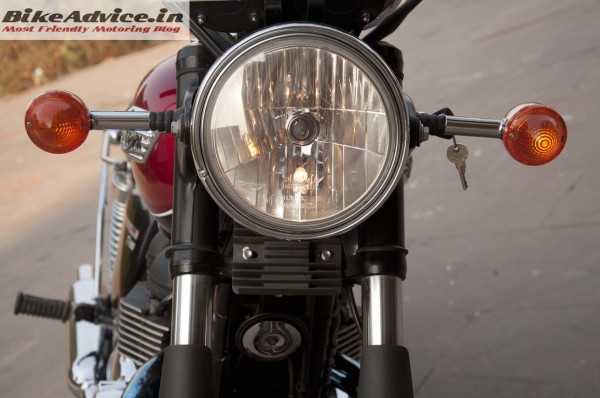

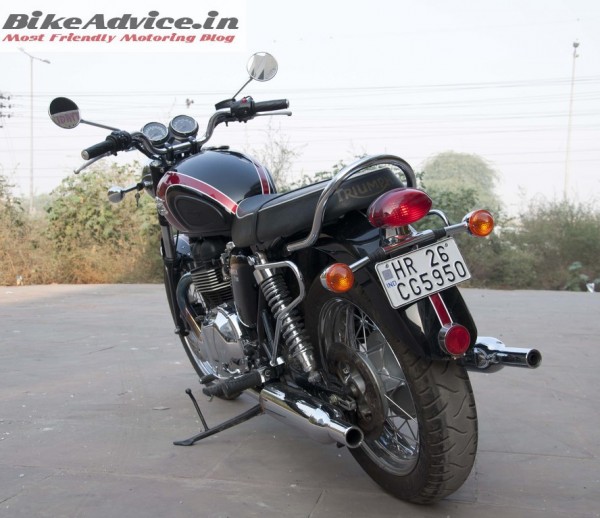

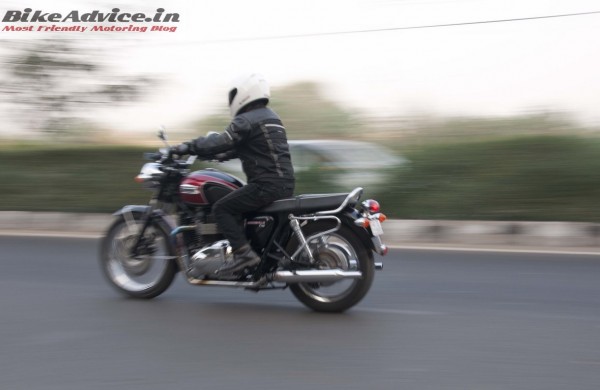
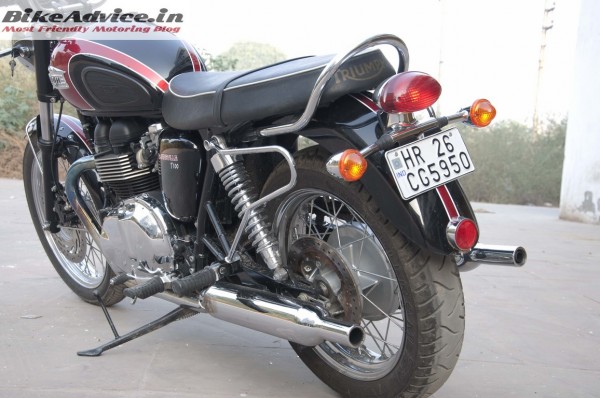
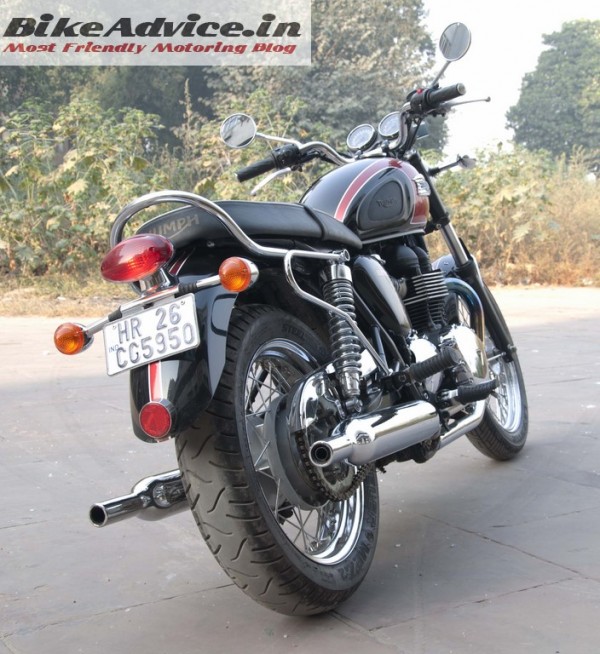
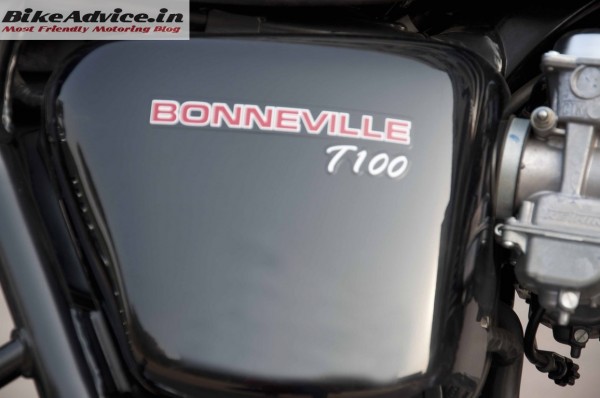
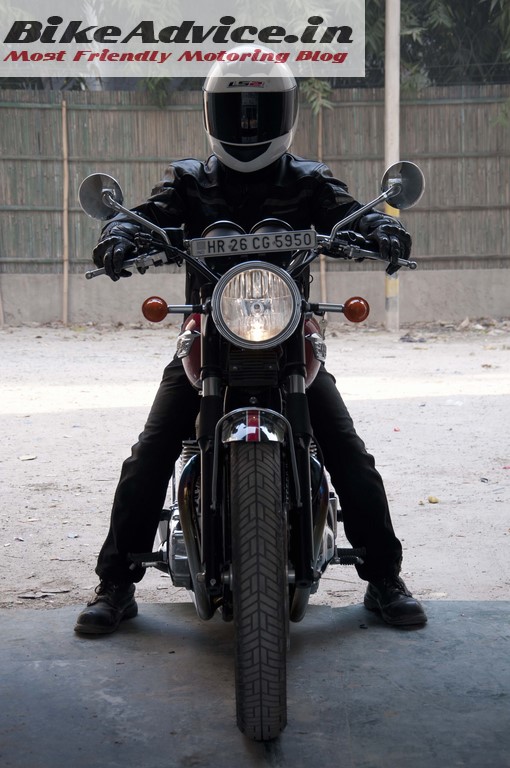
![Royal Enfield Guerrilla 450 Launch This Year [Speculation]](https://bikeadvice.in/wp-content/uploads/2022/12/Royal-Enfield-Hunter-450-pic-headlamp-100x70.jpg)
